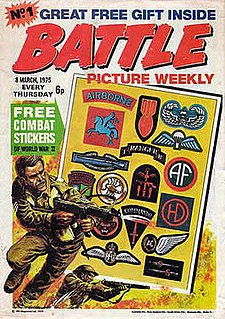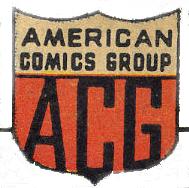Related Research Articles
Disney comics are comic books and comic strips featuring characters created by the Walt Disney Company, including Mickey Mouse, Donald Duck and Uncle Scrooge.

Knockout may refer to one of two British comics. The original series, published by the Amalgamated Press, started on 4 March 1939 and ended on 16 February 1963, when it merged with Valiant. The second series, published by IPC Magazines, ran from 12 June 1971 to 23 June 1973, when it merged with Whizzer and Chips.

Battle Picture Weekly, at various times also known as Battle Action, Battle Action Force, Battle and Battle with Storm Force, was a British war comic book magazine published by IPC Magazines from 8 March 1975 to 23 January 1988, when it merged with the new incarnation of Eagle. Most stories were set in World War II, with some based on other conflicts.

American Comics Group (ACG) was an [American comic book publisher started in 1939 and existing under the ACG name from 1943 to 1967. It published the medium's first ongoing horror-comics title, Adventures into the Unknown. ACG's best-known character was the 1960s satirical-humor hero Herbie Popnecker, who starred for a time in Forbidden Worlds. Herbie would later get his own title and be turned into a "superhero" called the Fat Fury.
Michael Anglo was a British comic book writer, editor and artist, as well as an author. He is best known for creating the superhero Marvelman, later known as Miracleman.

Atlas Comics is the 1950s comic-book publishing label that evolved into Marvel Comics. Magazine and paperback novel publisher Martin Goodman, whose business strategy involved having a multitude of corporate entities, used Atlas as the umbrella name for his comic-book division during this time. Atlas evolved out of Goodman's 1940s comic-book division, Timely Comics, and was located on the 14th floor of the Empire State Building.

L. Miller & Son, Ltd. was a British publisher of magazines, comic books, and pulp fiction intended primarily to take advantage of the British ban on importing printed matter. Between 1943 and 1966, the firm published British editions of many American comic books, primarily those of Fawcett Comics. They are best known for the 1954 creation of Marvelman – a blatant imitation of the Golden Age Captain Marvel – after America's Fawcett Publications capitulated to National Periodicals. L. Miller & Son also published a large line of Western comics, many reprints but also some original titles.
TV Comic was a British comic book magazine published weekly from 9 November 1951 until 29 June 1984. Featuring stories based on television series running at the time of publication, it was the first British comic to be based around TV programmes; it spawned a host of imitators.
TV Century 21, later renamed TV21, TV21 and Tornado, TV21 and Joe 90, and TV21 again, was a weekly British children's comic published by City Magazines during the latter half of the 1960s. It promoted the many science-fiction television series created by the Century 21 Productions company of Gerry and Sylvia Anderson. The comic was published in the style of a newspaper of the future, with the front page usually dedicated to fictional news stories set in the worlds of Fireball XL5, Stingray, Thunderbirds, Captain Scarlet and the Mysterons and other stories. The front covers were also in colour, with photographs from one or more of the Anderson series or occasionally of the stars of the back-page feature.
Playhour was a British children's comics magazine published by Amalgamated Press/Fleetway/IPC between 16 October 1954 and 15 August 1987, a run of approximately 1,700 weekly issues. Playhour contained a mixture of original tales for young children and adaptations of well-known fairy tales.
Ronald Sydney Embleton was a British illustrator who gained fame as a comics artist. In the 1950s and 1960s, Embleton also pursued a career as an oil painter, and he exhibited his works widely in Britain, Germany, Australia, Canada and the USA. He was a member of the London Sketch Club and the National Society of Painters, Sculptors and Printmakers, and in 1960 was elected a member of the Royal Institute of Oil Painters.
Gerry Embleton is a British artist, born in London. He is best known as an illustrator of military and historic subjects. He has illustrated more than 40 titles for the military publisher Osprey. He is the younger brother of illustrator Ron Embleton.
Toby Press was an American comic-book company that published from 1949 to 1955. Founded by Elliott Caplin, brother of cartoonist Al Capp and himself an established comic strip writer, the company published reprints of Capp's Li'l Abner strip; licensed-character comics starring such film and animated cartoon properties as John Wayne and Felix the Cat; and original conceptions, including romance, war, Western, and adventure comics. Some of its comics were published under the imprint Minoan. Some covers bore the logo ANC, standing for American News Company, at the time the country's largest newsstand distributor.
Key Publications was an American comic-book company founded by Stanley P. Morse that published under the imprints Aragon Magazines, Gillmor Magazines, Medal Comics, Media Publications, S. P. M. Publications, Stanmor Publications, and Timor Publications.
Farrell Publications is the name of a series of American comic book publishing companies founded and operated by Robert W. Farrell in the 1940s and 1950s, including Elliot Publishing Company, Farrell Comic Group, and Excellent Publications. Farrell is particularly known for its pre-Comics Code horror comics, mostly produced by the S. M. Iger Studio. Farrell also published romance, Western, adventure, superhero, and funny animal comics. Farrell acted as editor throughout. In addition to packaging art for Farrell from the beginning, Jerry Iger was the company's art director from 1955–1957.
Mickey Mouse Weekly was a 1936–1957 weekly British tabloid Disney comics magazine, the first British comic with full colour photogravure printing. The comic was inspired by the 1935 launch of Mickey Mouse Magazine, the first American Disney newsstand publication. 920 issues were published by Willbank Publications and then Odhams Press between 8 February 1936 and 28 December 1957. The comics were said to be "drawn in a slick, smooth style which was clearly influenced by American comics".

Princess Tina was a weekly British girls' comic published from fall 1967 to summer 1973 by the International Publishing Company, initially under the Fleetway Publications banner. Two comics, Princess and Tina, were merged to form Princess Tina; another title, Penelope, was merged into Princess Tina in 1969; the publication itself came to an end when it was merged into Pink.

Thorpe & Porter was a British publisher, importer, and distributor of magazines and comic books. At first, the company was known for repackaging American comics and pulp magazines for the UK market. Later on, it became a publisher of original material. The company released more than 160 comics titles in the UK, the most prominent being Classics Illustrated, MAD UK, Edgar Rice Burroughs' Tarzan of the Apes, Larry Harmon's Laurel & Hardy, House of Hammer, and Forbidden Worlds. T & P's most prominent imprints were Top Sellers Ltd. and Brown Watson. Thorpe & Porter operated from 1946 to c. 1979.
City Magazines was a British publisher of weekly comics and magazines that operated in the 1960s. The bulk of the company's publications were comics magazines based on licensed television properties. The most notable titles published by City Magazines were TV Century 21 and Lady Penelope, both of which featured comics based on Gerry Anderson's Century 21 Productions Supermarionation shows.

Princess was a weekly British magazine for girls, published from 30 January 1960 to 16 September 1967 by Fleetway Publications. The publication featured a mix of articles, features, and comic strips.
References
Citations
- 1 2 "British Comics Reference | British TV-related Comic Strips," DownTheTubes.net. Retrieved Feb. 25, 2021.
- ↑ "Express Weekly". wordpress.com. 30 March 2015.
- ↑ "W. E. JOHNS WORK IN EXPRESS WEEKLY AND TV EXPRESS WEEKLY". wejohns.com. Retrieved 17 April 2018.CS1 maint: discouraged parameter (link)
- 1 2 Steve Holland, Mike Western (1925-2008), Bear Alley, 20 May 2008
- ↑ Booklet accompanying the 1998 release of The World in Peril on audio cassette by BBC Worldwide Ltd